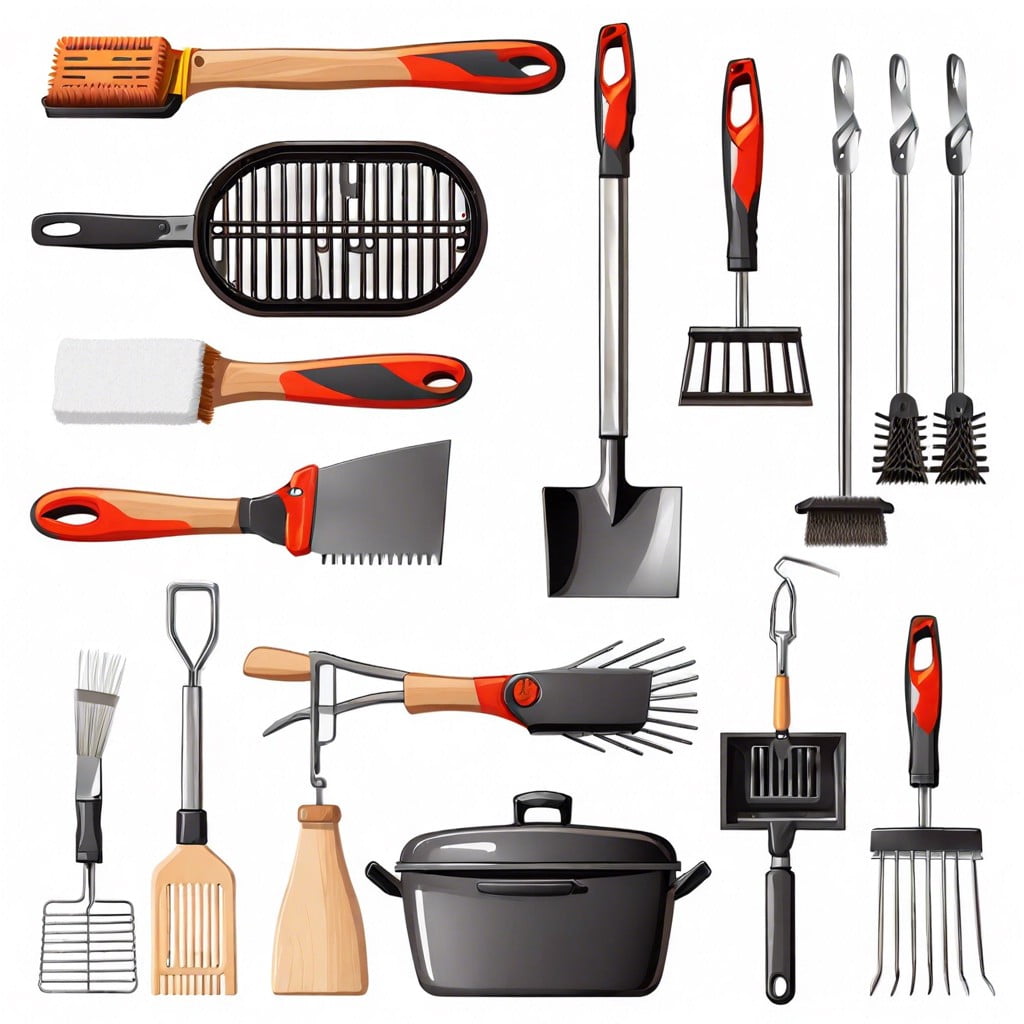Maintaining a clean grill is crucial for both food safety and optimal cooking performance; this guide outlines practical steps for effective grill cleaning.
Key takeaways:
- Use brass wire brushes and gloves for effective cleaning.
- Clean gas grills by turning up the heat and using a grill brush.
- Regular maintenance includes cleaning grates and wiping down the exterior.
- Deep clean gas grills by disconnecting propane tank and cleaning interior.
- Clean charcoal grills by discarding ashes and using vinegar and baking soda mixture.
Grill-Cleaning Equipment

Equipping yourself with the right tools is essential for effective grill maintenance. For both gas and charcoal grills, sturdy brass wire brushes are indispensable for removing caked-on food and grease. Brushes with a long handle protect hands from heat, while a scraper attachment can tackle tough residues.
Invest in a good pair of gloves to protect your hands from grease and possible injury. Grill-specific gloves offer the added benefit of being able to handle hot components if necessary.
For deep cleaning sessions, have a mild dish soap, a bucket for soapy water, and a sponge or dishcloth on hand. Stainless steel wipes or a dedicated grill cleaner can address exterior smudges and streaks, while a putty knife or grill stone can be used for particularly stubborn grime. Finally, a grill cover is your best ally to protect your grill from the elements when not in use, helping to keep it cleaner for longer periods.
How to Clean a Gas Grill
After each use, turning up the heat for 15 minutes can reduce food residue to ash. Switch off the grill, let it cool slightly, and then employ a grill brush on the grates to remove debris. For stainless steel grates, opt for a stainless steel brush to avoid damaging the surface.
For a deeper clean, which should be done at least twice a grilling season, begin by disconnecting the gas supply. Remove grates and metal plates to soak in soapy water. Use a putty knife to scrape off any buildup in the cook box. Clear out the burners of any blockages with a wire or pipe cleaner to ensure an even flame. Wash the drip pan with grease-cutting dish soap and replace any disposable pans as needed.
Check the exterior with a dedicated stainless-steel cleaner for those models, or a mild dish soap solution for others, then rinse and dry to avoid water spots. Lastly, protect your clean grill with a cover to guard against weather and outdoor debris.
After Each Use
Regular maintenance is essential for prolonging the life of your grill and ensuring that your food tastes great every time. Adopt a post-cooking regimen: allow the grill to stay hot for 15 minutes to carbonize any remaining food particles and grease. Use a brass wire brush to scrub the grates clean; brass is softer than stainless steel and won’t harm the grates’ finish.
For gas grills, cover the heating elements with foil to protect them while you clean. Wipe down the exterior with warm, soapy water and a cloth to keep the grill looking like new. Empty the drip pans or ash catchers frequently to prevent flare-ups and unwanted smoke. This simple routine prevents buildup and saves time when it comes to more thorough cleaning sessions.
Deep Clean
Embarking on a deep cleaning session is essential to long-term grill health and optimal performance. Tackle this task every few months to address the grime and residues that routine cleanings can miss.
Gas Grills:
- Disconnect the propane tank and remove the grates and burners to access the grill’s interior.
- Use a grill brush or putty knife to scrape off built-up carbon.
- Wash grates and burners with soapy water, rinse, and let them dry completely.
- Clear out the drip trays and wash them or replace disposable pans as needed.
- Clean the grill’s interior surfaces with a dedicated grill cleaner or a vinegar and water solution, rinse thoroughly.
- Inspect burner holes for blockages, using a toothpick or small wire to clear them.
Charcoal Grills:
- Remove and empty the ash catcher. Clean it with soapy water and a scrub brush.
- Take out the grates and clean them with a grill brush and soapy water.
- Scrape the inside of the grill lid and bowl to remove carbon build-up.
- Wash the grill’s interior with a grill cleaner or mild detergent, then rinse it out.
- Allow all parts to air dry completely before reassembling the grill.
Both Grill Types:
-
After reassembling, lightly coat the grates with cooking oil to prevent rust.
Check all connections, hinges, and hardware to ensure they are tight and in good condition.
This detailed approach keeps your grill hygienic, prevents unwanted flavor transfers, and extends the life of your equipment.
How to Clean a Charcoal Grill
For optimal performance, swiftly address ash and residue after each use. Begin by discarding cooled ashes into a metal container to prevent any fire risks. A grill brush proves invaluable in removing debris from the grates, so give them a good scrub.
For persistent gunk, a mixture of vinegar and baking soda creates an effective, natural cleaner—apply it to the grates, let it sit, then scrub and rinse.
Twice a year, aim for a more thorough cleaning. Dismantle the grill parts and use soapy water to cleanse the grates, the grill interior, and utensils. A putty knife comes in handy for scraping away charred material from the grill bottom. Rinse parts thoroughly and reassemble once everything is dry.
Proper care extends your grill’s lifespan and ensures ready-to-use condition for your next cookout.

